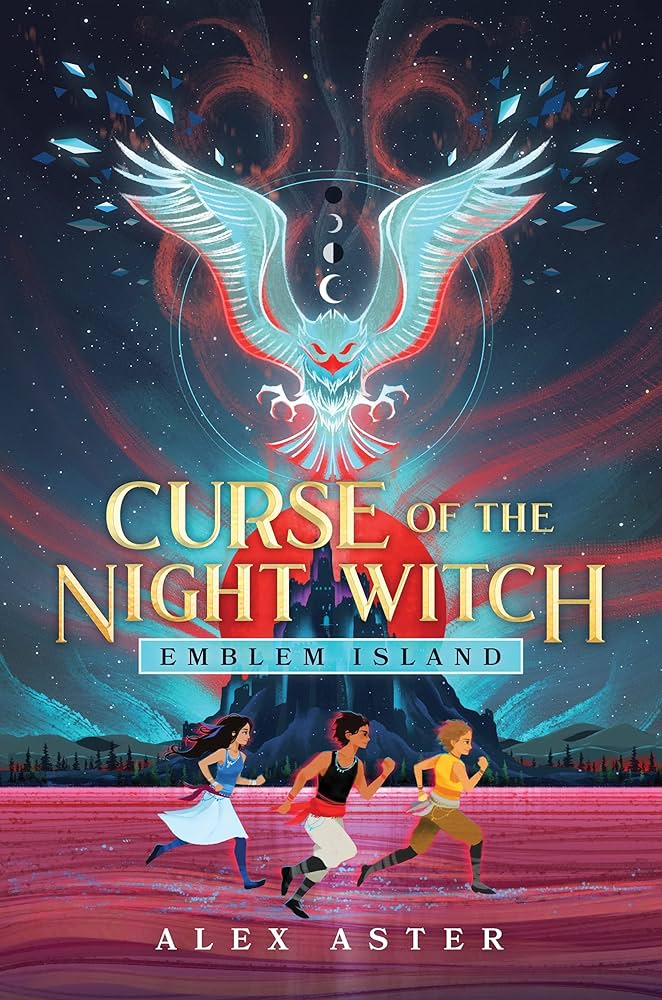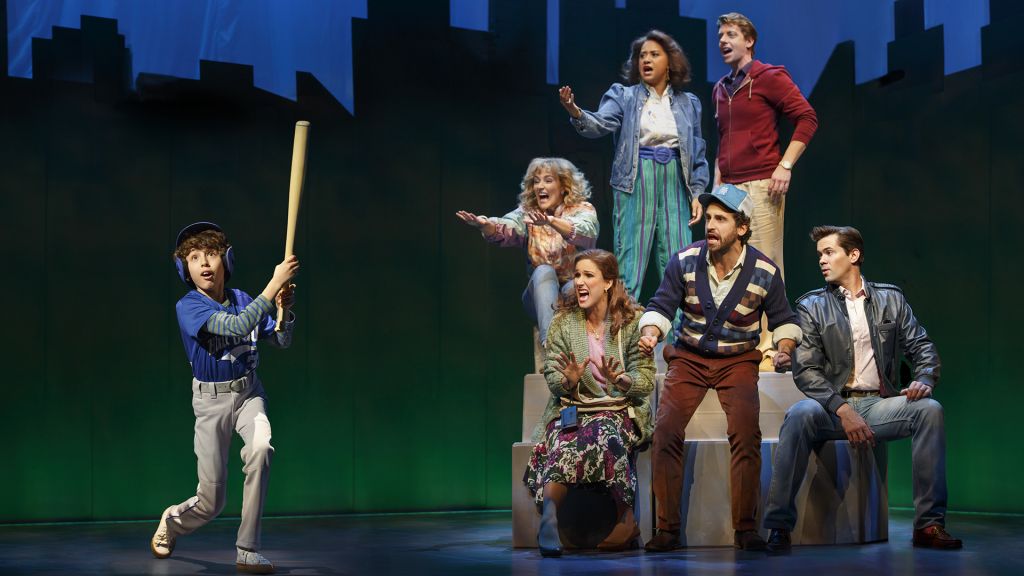You may have heard of the popular BookTok novel Lightlark by Alex Aster, but there’s a good chance you haven’t heard of her debut children’s series, Emblem Island.
While similar in their Fantasy genre, Lightlark focuses on the story of rulers competing on a secret-filled hidden island, whereas the first book of Emblem Island, Curse of the Night Witch, follows three kids as they navigate an island filled with folktales and mythical creatures. Curse of the Night Witch is rated 4.5 on Amazon and the direct summary of the book, pulled from the novel itself, is, “After changing the fate he has known since birth, twelve-year-old Tor Luna, accompanied by his friends Engle and Melda, must visit the notorious Night Witch to break the curse he now faces.” Inspired by Colombian folklore, Curse of the Night Witch will bring you into a world full of vibrant colors, creatures, and events. However, there are some flaws that keep this book from being as good as it could’ve. Here’s a full rundown.
Comparison
Curse of the Night Witch is a Fantasy book intended for children aged 12 and under, meaning it’s going to run into some similarities with other kid series. The most popular comparisons that have shown up are Percy Jackson, for the idea of a world based on cultural stories, and Harry Potter for the magic (obviously) and friend group.
While the concept of the book is definitely similar to Percy Jackson, it manages to take its own completely different route, which sets it apart from other mythology-inspired series that feel like plain copies of Percy Jackson. Percy Jackson focuses more on the gods, prophecies, and mythical creatures, while the world of Emblem Island is more like a storybook come to life.
With Harry Potter, though, the resemblance to the main three (Harry, Ron, and Hermione) is very evident. As I was reading this book, I wondered why the friend group worked so well—none of the friends fell victim to harmful stereotypes, nobody stuck to one trait only, the female character wasn’t perfect while the boys were idiots—and I got the answer to this question after reading the online reviews. Tor, Engle, and Melda were extremely similar to the characters of Harry Potter. There was Tor, the cursed main character who was struggling to lead and had his friends always there to back up; Engle, the comedic-relief side character who really liked eating food, yet was actually more helpful than he initially appeared; finally, Melda, the smartest of the group who kept her friends in line but had her own flaws.
So, if you enjoyed Harry Potter because of the friend group and would like to see that friendship revived in a new journey, you may want to try this book out (but keep reading because the plot is still important). If you are going to be bothered by the idea that the book “ripped off Harry Potter,” put this review down and find a different book.
Would I say the book ripped off Harry Potter? No, absolutely not. The only thing inspiration was really taken from was the friend group dynamic. The characters still have different stories from the characters of HP, and the plot, magic system, and world are incredibly different. How so? Let’s get into that.
Plot
The plot was one of the positives of this book. The pacing was good (though it did get slow), the characters don’t face ridiculous plot armor, they have their own struggles, and it’s all structured very well for the target audience. Before you continue reading, it is VERY, VERY important to remember that this is a KID’S BOOK.
In Curse of the Night Witch, the main characters use the “Book of Cuentos,” a storybook well-known on the island, to guide their journey once they realize the stories of the book may not actually be stories. While the idea of “the stories they thought were tales are actually real” is a bit generic and overused, Alex Aster manages to use components of other books to keep this plot point from feeling bland, and I’ll explain why in the “Writing Style” section of this review.
However, I do recommend that if you’re not a fan of the simplicity of children’s books, you may not like the plot as much. There are many events in the book that can be seen as repetitive if you’re looking for a solid climb through the story. Books not targeted for children typically have more complex plots, looking to use the events for a big build up, and books intended for children—specifically of the action or fantasy genre—have many events where the character must fight something, but for the sole purpose of entertainment and/or to get the plot moving.
This is, in part, what this book does. Throughout the course of the story, the children come across monsters that they either have to defeat or evade. The idea of each situation goes as follows: encounter a monster, panic, get—or almost get—slightly wounded/hurt, have friends come to save them or create an intuitive plan, move on. A typical novel written for a higher age would normally use a close call situation like this to have some sort of meaning towards later on, but since Curse of the Night Witch isn’t for a higher age group, these fight scenes just serve as filler for the plot. Still, I won’t say these scenes don’t serve their purpose. They were written in a way that you could picture (almost) everything, and they got you through the book—albeit a little slowly.
If you’re worried about being bored to death from the repetition, that’s actually not a big issue. As long as you’re a kid—and I would know—looking for adventure, you will be fine. If you read things like Percy Jackson and watch shows/read books where the characters have to encounter many obstacles before reaching their goal, the plot won’t bother you. Yes, at times it feels like the characters are just fighting monsters, but you can also see the characters start to trust each other more and each obstacle reveals a little more about them. To add onto that, the fight scenes are also varied so it doesn’t feel like a “same text, different font” situation.
If you’re not a kid like that, and are rather one that would prefer a perfectly fitted plot where everything has meaning and there are deep, underlying themes, there are many other options out there. Do not feel obligated to read this book, because you can put your time to use with something else.
Now, back to the plot in general, I do have one complaint about the plot, and it’s that this book didn’t reach its full potential. Emblem Island had such a cool concept (colorful lines on your palms that show your fate, a storybook that also serves as a path to an adventure, markings that give you an ability, so much backstory to the creation of the island itself, the value of color in the world), and I am a little sad that it worried more about the quantity of the writing over the quality. The fight scenes were described, you learned of the story of the creatures they fought, but the story missed the point to put depth that’d be fitting for a children’s book, the Night Witch as a character especially. Aster brought up a lot of unanswered questions within the world of Emblem Island, and I’m just wishing they’ll be expanded upon in the rest of the series.
Worldbuilding
At first glance, the worldbuilding of Curse of the Night Witch seems entirely fine. That is, until you take the time to pick it apart, which is what I had to do for this review. Trying to figure out what time this story took place was probably the hardest for me.
In the first chapter, you get the idea that the characters who live in Estrelle, Tor’s village that lies at the edge of the island, would live like islanders do. There were mentions of “island” and “morning song” and “village chief” and “writing on leaves” that make you think the people live more traditionally, and I think this is the part where Aster struggled. It feels like she combined part modern aspects with part traditional customs to make a world that was easier to write. For example, the characters act like they belong to a very modern timeline, and in the beginning when Tor was in his house, things were described as similar to today. Their village also included many urban attributes when it felt like Aster was trying to get across that it wasn’t city-like—hence “village,” and “chief.” That was my main complaint about this world. Other than that, your comprehension of the rest of the world got better because as you went along, the world turned into much more fantasy, and you could tell that the idea was that the characters existed somewhere in the past (or at least somewhere without modern technology).
The magic of the world and the differences from a realistic world are pretty well developed compared to the communities. The characters have emblems, markings on a part of their body that give them special abilities, and lifelines, rainbow streaks across their palms that read your future. Each of these things have a specific backstory, backstories that are described in the Book of Cuentos. There’s a place called “The Shadows” that is supposed to refer to the place that creatures lurk (because they live in the shadows), and as the characters get closer to this place—a place completely devoid of color—the vibrancy of the towns start to leech. There are mythical creatures, all of which were created by Alex Aster (or at least I think that’s the case), so there isn’t overlap between two different cultures. This is very easy to understand and follow, and it didn’t result in any plot holes. The confusion seemed worst at the beginning, when trying to understand Tor’s village.
My final take on the worldbuilding of Emblem Island? The world itself and its concepts are cool, though bits and pieces of it feel undone. I think that if Alex Aster had taken the time to go over her worldbuilding a little before writing the book, it could’ve been perfect, or at least almost perfect. Again, I don’t know what’s going to be resolved in the second book or the future of the series because I haven’t read the rest of the series yet. Do with this information what you want, and just understand what you’re getting into if you choose to read this book.
Writing Style and Formatting
What I loved most about the style of Curse of the Night Witch was how Alex Aster paired the general chapters with direct stories from the Book of Cuentos to foreshadow and provide more context to the general plot, as the characters are using that book to make their journey. Each additional snippet was placed in a well-thought out manner, and it snaps into place with the rest of the plot even if you don’t realize it at first. This is one of the reasons I enjoyed the book, and it’s also a main reason the book didn’t feel bland style-wise. I’d definitely give this aspect of the book a 5/5 (4.5/5 at worst) in rating.
Next, though, Alex Aster’s own writing style during the book is what I didn’t like as much, but that’s just personal preference. There were times when I felt wording could be better, and she reused some comparisons unnecessarily. However, that’s a pet peeve of mine in many books. The writing style is fit for a kid and isn’t going to be flawless, so this doesn’t matter much, I just wanted to give my take on the writing.
Character Depth
I really loved the characters of Curse of the Night Witch, and this is where so much potential was missed. In the book, you hear brief mentions of each of the character’s background and home life, but Aster didn’t focus on it as much as she focused on continuing the story. It’s like she built the idea of the character, then forgot to execute it.
For example, Melda and Engle. They each had very prominent personalities that made them feel like real people, but they had problems going on in their life that were vaguely mentioned as problems. Melda lived in a big family with overworked parents and sick brothers, leaving her as the one who had to do the most work in her family. This made so much sense for why she wanted to be a leader and why she was always determined to be good. Some of the way throughout the story, after the friends had endured much together, Melda admits how she was always one-upping Tor because she wanted to prove herself. Tor’s mother was the chief, and how was she supposed to compare with that? If Alex Aster had written more on that, even just spreading parts of it evenly throughout the story, it could’ve given Melda’s character so much more. Instead, it feels like she just threw it on there to give Melda a character arch. Again, I haven’t read the next book yet, so there’s still a possibility for this to be expanded upon later. I really hope that’s the case.
Next, there’s Engle. Out of all of them, Engle’s family life is the most blurred. There’s a scene where the characters come across illusions of their family, trying to trick them into failing a challenge. Engle is written to not have hesitated to walk past the illusion, knowing his parents wouldn’t have cared about him that much. Engle’s neglect is mentioned in other parts of the story, but never really explained. This. Could’ve. Been. So. Good.
Tor’s character also felt a little flat. Like his friends, he also had traits that could’ve been explored to give him depth. His mother’s the chief, which put pressure on him as the oldest child and the one with the leadership emblem. He’s expected to lead, when what he wants to do is swim, so much that he wishes for another emblem. He learns lessons along the way, has to deal with the fact that sometimes he has to let other people lead, and realizes he didn’t want to be a leader because he didn’t disappoint anyone—it wasn’t the emblem he hated, it was the pressure. This would’ve been great if it had been a show-don’t-tell scenario, not a dump-it-on-the-readers scenario.
In short, while all the characters had their flaws and didn’t feel annoyingly perfect, there was an opportunity loss with their depth. I understand this is a kid’s series, but the best kid’s series were the ones that weren’t afraid to take a chance on putting a little more complex themes into their characters, because the child either understood or didn’t, and that didn’t take away drastically from the plot. Focusing on these characters also would have kept the plot from feeling filler-filled and more worth its length. BUT, the characters do act their age—mature enough to problem-solve but still young enough to make childish mistakes—and that’s a plus. Aster definitely knows how to write believable pre-teens.
Conclusion
In conclusion, this book is nothing special or extraordinary, but it isn’t bad. To be honest, it feels like many of the other minorly-popular fantasy children’s books: good, but not as good as the famous ones. It really just comes down to preference for whether or not this book is worth reading. Does the idea of a magical storybook world outweigh the possibility of less character depth? Is the time the book is set in going to bother you the entire time? Is every small problem going to bother you? Ask yourself those questions. I don’t think I drastically lost anything from spending the time on this book, but I don’t think it was worth the 300+ pages. If Alex Aster had mixed those battle scenes and the journey with well-measured character reflection, I think that would’ve made the story feel more fulfilled.
Either way, this is completely up to you. I really think you should give it a go if you’re looking for an action-filled story with heartwarming friendship. It’s better than Lightlark; so if you liked Lightlark for the world concept, read it, and you didn’t like Lightlark for the plot holes, you still may like this book.
Happy reading!







